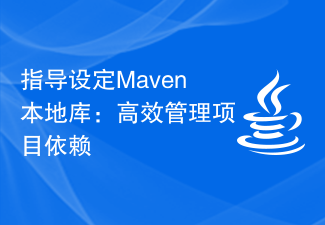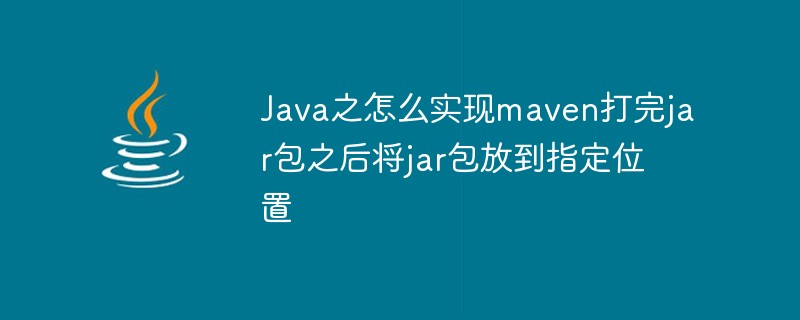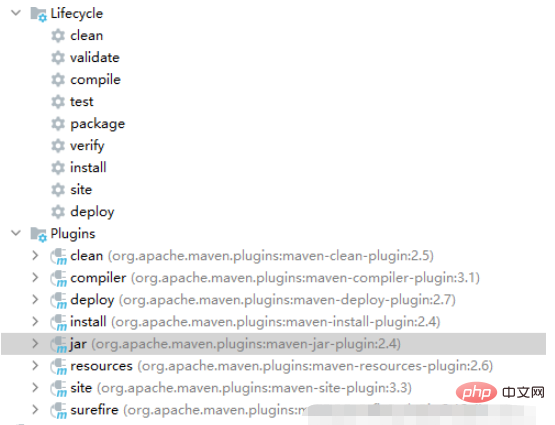 Java
Java javaTutorial
javaTutorial Experience Sharing: Overcoming Barriers to Project Construction and Dependency Management - Maven Practice Guide
Experience Sharing: Overcoming Barriers to Project Construction and Dependency Management - Maven Practice Guide
As an open source project management tool, Maven is widely used in Java development. It can help developers solve the problems of project construction and dependency management. This article will share some practical experience with Maven to help readers better understand and apply Maven.
As an open source project, Maven has many advantages. First, it can uniformly manage the dependency libraries of the project. In Java development, we often use many third-party libraries to implement various functions, and there are dependencies between these libraries. Using Maven, we can manage these dependencies through simple configuration files, reducing the workload of manually downloading and managing dependencies. Just declare the required dependencies in the pom.xml file, and Maven will automatically download and install them.
Secondly, Maven can automate the project build process. Usually, the construction of a project includes multiple steps such as compilation, testing, packaging, and deployment. Using Maven, we only need to define these steps in the pom.xml file, and then execute the maven command, and Maven will automatically execute these steps to achieve automatic construction of the project. Maven's automated builds reduce human errors and increase development efficiency compared to performing these steps manually.
In addition, Maven also provides a powerful plug-in mechanism that can extend and customize the project build process. Maven plug-ins are independent programs that perform specific tasks during the build process. By using Maven plug-ins, we can implement various functions, such as static code analysis, code coverage checking, code quality assessment, etc. There are many open source Maven plug-ins to choose from, and developers can also develop their own plug-ins to meet project-specific needs.
However, in practice, we may encounter some problems and challenges. First, project dependency management can become complex. In a large project, there may be multiple modules involved, and each module may have different dependencies. Without a good management strategy, a project's dependencies can become confusing, leading to build errors and runtime issues. In order to solve this problem, we should adopt reasonable project architecture and dependency management strategies. The project can be divided into multiple modules, each module is only responsible for its own functions and clearly defines dependencies. Use Maven's dependency management mechanism in pom.xml to manage these dependencies to ensure that the dependencies of each module are consistent.
Secondly, Maven's build process may become slow. In a complex project, there may be a large amount of code that needs to be compiled and processed, which can cause the build process to become slow. To speed up the build process, we can employ some optimization strategies. For example, use a local Maven repository to cache dependencies to avoid repeated downloads; use incremental compilation to compile only modified code; rationally select and configure various plug-ins to reduce build time, etc. In addition, you can also use distributed build tools, such as Jenkins, to achieve parallel builds and resource sharing, further improving build efficiency.
Finally, there may be a certain learning curve in the use and configuration of Maven. Especially for beginners, it can be confusing and confusing. In order to better master Maven, we should read official documents and related tutorials to understand the basic concepts and usage of Maven. You can improve your proficiency through practice and practice, and communicate and share experiences with other developers.
In short, Maven is a powerful and flexible project management tool that can help us solve the problems of project construction and dependency management. By using Maven properly, we can better manage project dependencies, realize automated project construction, and extend and customize the project build process. However, some problems and challenges may be encountered in practice, and we should adopt corresponding strategies and measures to solve these problems. I hope that the sharing of this article can help readers better understand and apply Maven.
The above is the detailed content of Experience Sharing: Overcoming Barriers to Project Construction and Dependency Management - Maven Practice Guide. For more information, please follow other related articles on the PHP Chinese website!
 指导设定Maven本地库:高效管理项目依赖Feb 19, 2024 am 11:47 AM
指导设定Maven本地库:高效管理项目依赖Feb 19, 2024 am 11:47 AMMaven本地仓库配置指南:轻松管理项目依赖随着软件开发的发展,项目的依赖包管理变得越来越重要。Maven作为一个优秀的构建工具和依赖管理工具,在项目开发过程中扮演着至关重要的角色。Maven默认会从中央仓库下载项目依赖,但有时候我们需要将一些特定的依赖包保存到本地仓库中,以便离线使用或避免网络不稳定的问题。本文将介绍如何配置Maven本地仓库,以便轻松管理
 Java之怎么实现maven打完jar包之后将jar包放到指定位置May 13, 2023 am 11:46 AM
Java之怎么实现maven打完jar包之后将jar包放到指定位置May 13, 2023 am 11:46 AM方式一通过maven-jar-plugin指定outputDirectory输出路径可以排除某些配置文件,没有文件夹的话会自动创建!org.apache.maven.pluginsmaven-jar-pluginD:\test**/*.properties**/*.xml**/*.ymlstatic/**templates/**方式二通过maven-resources-plugin指定outputDirectory输出路径org.apache.maven.pluginsmaven-resourc
 Java之Maven工程打包jar的方法是什么Apr 29, 2023 pm 06:31 PM
Java之Maven工程打包jar的方法是什么Apr 29, 2023 pm 06:31 PMMaven打包一般可以生成两种包一种是可以直接运行的包,一种是依赖包(只是编译包)。Maven默认打包时jar,如果需要修改其他类型。可以修改pom.xmljar/ear/ejbMaven工程默认引入的插件:1.一般的jar(不能运行)生成的jar只是一个编译包,并没有打包依赖jar包。通过控制台的编译日志可以看出来,方式使用maven-jar-plugin:2.4插件。java编译插件,可以设置jdk的版本等(如果不设置使用默认,可以不设置org.apache.maven.pluginsmav
 什么是Composer,它与PHP的关系是什么?May 12, 2023 pm 08:31 PM
什么是Composer,它与PHP的关系是什么?May 12, 2023 pm 08:31 PM随着现代Web开发技术的迅速发展,依赖管理成为了一个越来越重要的议题。无论是前端还是后端开发,我们需要引入各种各样的库和框架来达到更高的开发效率和更好的应用性能。而这些库和框架的组织、版本控制和安装管理问题则成为了一个值得思考和解决的难题。Composer就是为了解决PHP应用开发中依赖管理问题而推出的一个开源工具。它的作用类似于Node.js
 如何进行C++代码的依赖管理?Nov 04, 2023 pm 03:45 PM
如何进行C++代码的依赖管理?Nov 04, 2023 pm 03:45 PM如何进行C++代码的依赖管理?作为一种广泛使用的编程语言,C++常常用于开发涉及底层硬件、系统级别或具有高性能要求的应用程序。在实际开发中,C++项目往往会涉及到各种库、框架和其他依赖项,因此,进行代码的依赖管理变得尤为重要。本文将介绍几种常见的C++代码依赖管理方法,帮助开发者更好地管理项目中的依赖关系。一、手动复制依赖库最简单的依赖管理方法是手动将所需的
 Golang 框架中常见的依赖管理问题有哪些?Jun 05, 2024 pm 07:27 PM
Golang 框架中常见的依赖管理问题有哪些?Jun 05, 2024 pm 07:27 PMGo框架依赖管理中的常见问题和解决方案:依赖项冲突:使用依赖关系管理工具,指定接受版本范围,检查依赖项冲突。供应商锁定:通过代码复制、GoModulesV2文件锁定或定期清理供应商目录来解决。安全漏洞:使用安全审计工具,选择信誉良好的提供商,监控安全公告并及时更新依赖项。
 * Java 函数包管理和依赖关系:如何保持代码库的整洁和可维护性Apr 24, 2024 pm 02:33 PM
* Java 函数包管理和依赖关系:如何保持代码库的整洁和可维护性Apr 24, 2024 pm 02:33 PM问题:如何管理Java函数包和依赖关系?答案:使用函数包管理器(如Maven或Gradle)来声明依赖关系。在pom.xml或build.gradle文件中指定依赖项的坐标和范围。使用Maven或Gradle命令构建项目,以解析和管理依赖关系。
 Maven 独孤九剑:Java 构建之无招胜有招Mar 08, 2024 pm 01:20 PM
Maven 独孤九剑:Java 构建之无招胜有招Mar 08, 2024 pm 01:20 PM1.Maven的无招胜有招Maven的核心思想在于遵循约定优于配置。它提供了一套默认规则,指导项目构建过程,而开发者只需根据特定需求进行少量定制。这种无招胜有招的策略赋予Maven极高的灵活性,使其适用于各种Java项目。2.项目结构约定Maven对项目结构有严格约定,包括目录组织和文件命名规则。项目根目录下一般包含以下子目录:src/main/java:存放源代码src/main/resources:存放资源文件src/test/java:存放测试代码src/test/resources:存放


Hot AI Tools

Undresser.AI Undress
AI-powered app for creating realistic nude photos

AI Clothes Remover
Online AI tool for removing clothes from photos.

Undress AI Tool
Undress images for free

Clothoff.io
AI clothes remover

AI Hentai Generator
Generate AI Hentai for free.

Hot Article

Hot Tools

Dreamweaver Mac version
Visual web development tools

MantisBT
Mantis is an easy-to-deploy web-based defect tracking tool designed to aid in product defect tracking. It requires PHP, MySQL and a web server. Check out our demo and hosting services.

PhpStorm Mac version
The latest (2018.2.1) professional PHP integrated development tool

SublimeText3 Chinese version
Chinese version, very easy to use

mPDF
mPDF is a PHP library that can generate PDF files from UTF-8 encoded HTML. The original author, Ian Back, wrote mPDF to output PDF files "on the fly" from his website and handle different languages. It is slower than original scripts like HTML2FPDF and produces larger files when using Unicode fonts, but supports CSS styles etc. and has a lot of enhancements. Supports almost all languages, including RTL (Arabic and Hebrew) and CJK (Chinese, Japanese and Korean). Supports nested block-level elements (such as P, DIV),





